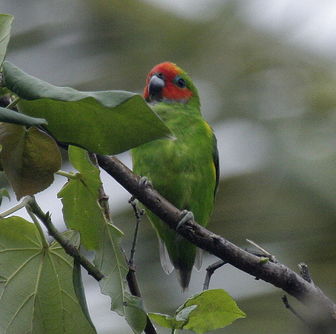Double-eyed Fig-Parrot
Most subspecies of the Double-eyed Fig Parrot are sexually dimorphic, with males having more red to the face than the females. It is predominantly green with a very short tail, a disproportionately large head and bill, and red and blue facial markings. Its name is derived from the cheek patches of some subspecies that vaguely resemble eyes.

Original source: AvicedaCamera location
Author: AvicedaCamera location
The Double-eyed Fig-Parrot is classified as Least Concern. Does not qualify for a more at risk category. Widespread and abundant taxa are included in this category.
The Double-Eyed Fig-Parrot is sexually dimorphic, with males having a much brighter plumage than females. Both sexes have a red forehead, but the males also have a red cheek patch, while the females' tends to be yellow. They can be distinguished from small lorikeets by their short tail and lack of under-wing color. More
The Double-eyed Fig-parrot is Australia's smallest parrot and can be identified by a red forehead and a red or yellow patch on the cheek depending whether the parrot is male or female (respectively.) The Double-eyed Fig-parrot (also known as the Lorilet) features a green-yellow plumage and normally grow to 13-15 cm. Double-eyed Fig-parrots nest in dead tree trunks and have been declared rare in the Wet Tropics region. More
The Double-eyed Fig-parrot generally forages for figs, berries, seeds, nectar, and the grubs of wood-boring insects. However, once they stop to feed, they are usually quiet and rarely seen due to their diminutive size. This animals foraging is done in pairs or in a flock consisting of a few small animals. They tend to fly in a quick and direct manner and produce short and shrill calls throughout their habitat. More
The Double-eyed Fig-parrot generally forages for figs, berries, seeds, nectar, and the grubs of wood-boring insects. This foraging is done in pairs or in a flock of only a few individuals. It tends to fly in a quick and direct manner. It produces a short and shrill call. Their nesting behavior consists of boring a hole into a rotten tree. Subspecies - There are eight described subspecies of the Double-eyed Fig-parrot. More
priority actions to help recover the Double-eyed Fig-Parrot in New South Wales. What needs to be done to recover this species? - * Retain and protect areas of rainforest and adjoining wet eucalypt forest. * Preserve remnant large fig trees on farmland. * Contribute to the replacement of habitat by planting appropriate fig trees on farms. More
The Coxen's Double-eyed Fig-parrot Cyclopsitta diopthalma coxeni is Australia's smallest and most endangered bird. So rare that it has never been photographed, it hides from human eyes in the lush canopy of the coastal rainforest of northern New South Wales and Queensland. Its plumage makes it look similar to some species of lorikeet, and the only distinguishing features are an extremely short tail, over large head and overall green, dumpy appearance. More
three sub-species of Double-eyed Fig-Parrot found in Australia. The others are Macleay's (C. d. macleayana) and Marshall's (C. d. marshalli) Fig-Parrots, both of which are found in tropical north Queensland. It has been proposed that Coxen's is a separate species, however, until we can obtain fresh material for DNA testing, their taxonomic status will remain a subject for conjecture. More
Family : Psittacidae
Genus : Cyclopsitta
Species : diophthalma
Authority : (Hombron & Jacquinot, 1841)

